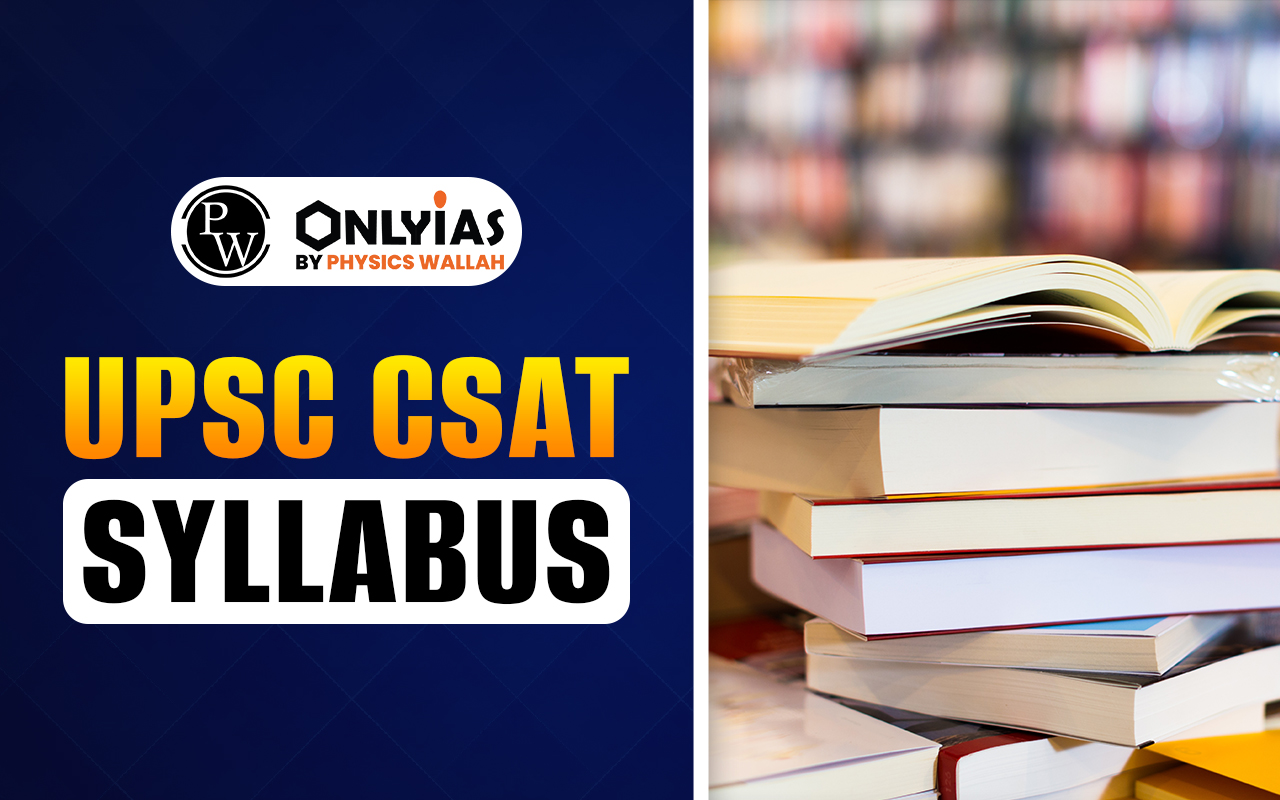Understand UPSC CSAT Syllabus 2026 in detail with topic-wise coverage and section weightage. Download the syllabus PDF and learn how to prepare for the exam.

UPSC CSAT Syllabus 2026: The Civil Services Aptitude Test (CSAT) is an essential paper of the UPSC Prelims examination. Candidates need to score a minimum of 33% marks to qualify the CSAT Paper. Even though the paper is qualifying in nature, the level of questions has increased over the years.
CSAT paper that tests the aspirant’s presence of mind and fundamental problem-solving ability rather than memorization. It is important for aspirants to understand the UPSC CSAT Syllabus 2026 as it helps them prepare effectively for this qualifying paper.
Knowing the basic structure of the CSAT paper can help you prepare accordingly for the exam. UPSC CSAT Syllabus 2026 evaluates a candidates’ aptitude, logical reasoning, and decision-making abilities necessary for administrative responsibilities. It includes objective-type questions focused on aptitude, reasoning, and comprehension. Here’s a brief overview of UPSC CSAT Syllabus 2026:
|
UPSC CSAT Syllabus 2026 Overview |
|
| Section | Topics Covered |
| Comprehension | Reading comprehension passages and answering related questions |
| Interpersonal and Communication Skills | Questions to test interpersonal skills and communication clarity |
| Logical Reasoning & Analytical Ability | Puzzles, blood relations, directions, coding-decoding, patterns, etc. |
| Decision-Making & Problem-Solving | Situation-based questions assessing judgment and administrative decision-making |
| General Mental Ability | Numerical reasoning, series completion, pattern recognition |
| Basic Numeracy (Class X level) | Number system, percentages, averages, ratios, time & work, profit & loss, etc. |
| Data Interpretation (Class X level) | Charts, graphs, tables, data comparison, and calculation |
You can download the UPSC CSAT Syllabus 2026 PDF topic-wise from the official UPSC website. The topic-wise syllabus helps students focus on their preparation strategically. The major sections include:
The CSAT 2026 syllabus can be broadly categorized into six major topics:
Each of these topics are divided into various subtopics, making it essential for candidates to cover each topic thoroughly.
The UPSC CSAT (Civil Services Aptitude Test) syllabus 2026 covers broad areas like comprehension, interpersonal skills, logical reasoning, decision-making, problem solving, general mental ability, data interpretation, and basic numeracy. There is no specific topic weightage given, but it assesses students’ analytical, problem-solving, and aptitude skills. Here are UPSC CSAT Exam Expected Topic Wise Weightage:
| UPSC CSAT Syllabus 2026 Topic Wise Weightage | |
| Topic | Expected Weightage (%) |
| Comprehension | 20% |
| Interpersonal Skills | 15% |
| Logical Reasoning | 25% |
| Decision Making and Problem Solving | 10% |
| Basic Numeracy | 15% |
| English Language Comprehension | 10% |
| Data Interpretation | 5% |
UPSC CSAT Maths Syllabus 2026 includes topics like L.C.M & H.C.F., number systems, rational numbers, percentages. This section tests candidates on various mathematical concepts that are essential for solving problems effectively in the exam.
The topics covered under the UPSC CSAT Syllabus 2026 for Maths are diverse, ranging from basic arithmetic to complex data interpretation. Here is the detailed UPSC CSAT Maths Syllabus 2026 for better understanding.
| UPSC CSAT Maths Syllabus 2026 | |
| Basic Numeracy | General Mental Ability |
| Number System | Time & Work |
| Rational Numbers & Ordering | Time and Distance |
| L.C.M & H.C.F | Trains |
| Square Roots & Cube Roots | Boats & Streams |
| Decimal Fractions | Pipes & Cisterns |
| Averages | Work & Wages |
| Ratio & Proportion | Profit & Loss |
| Percentages | Partnership |
| Simplification | SI and CI |
| Surds & Indices | Mensuration & Area |
| Divisibility Rules | Alligation & Mixtures |
| Remainder Theorem | P & C |
| Set Theory | Probability |
| Geometry | |
UPSC CSAT Reasoning syllabus 2026 aims to assess analytical and logical abilities of the candidate. This section evaluates how well candidates can think through problems, understand patterns, and draw logical conclusions.
The syllabus is divided into two areas: Logical Reasoning & Analytical Ability (LR & AA) and Data Interpretation & Data Sufficiency (DI & DS). These sections require clarity in logic, understanding of the structured data, and the ability to make quick judgments under time pressure. Here are some topics included in the reasoning section:
| UPSC CSAT Reasoning Syllabus 2026 | |
| Logical Reasoning & Analytical Ability (LR & AA) | Data Interpretation & Data Sufficiency (DI & DS) |
| Mathematical puzzles & patterns | Alphabet test |
| Statements & conclusions | Coding-decoding |
| Cubes & dice | Blood relation |
| Deriving conclusions | Seating arrangement |
| Syllogism | Logical Venn diagrams |
| Clocks | Direction sense test |
| Table, bar, and pie charts | Mathematical operations |
| Statement & assumptions | Series |
| Cause & effect | Classification |
| Calendars | Analogy |
| Analytical reasoning | Arithmetical reasoning |
| Statements & arguments | |
| Number ranking | |
| Time sequence tests | |
| Situation reaction tests | |
| Punch lines | |
UPSC CSAT Reading Comprehension Syllabus 2026 include Passages from topics based on economics, philosophy, environment, sociology, and current affairs. Based on the passages, questions may test:
The questions aim to assess clarity of thought, linguistic precision, and interpretive skills.
UPSC Prelims CSAT Paper Pattern 2026 follows a structured pattern and assesses a candidate’s aptitude and problem-solving skills. Although it’s a qualifying paper, understanding the exam pattern is crucial to plan preparation and manage time effectively. Here is the UPSC
| UPSC Prelims CSAT Paper Pattern 2026 | |
| Particulars | Details |
| Exam Mode | Offline (OMR-based) |
| Total Questions | 80 |
| Marks per Question | 2.5 |
| Total Marks | 200 |
| Duration | 2 Hours |
| Medium | English and Hindi |
| Types of Questions | Objective and Multiple Choice Questions |
| Negative Marking | Yes (0.83 marks per wrong answer) |
| Qualifying Marks | 66.67 (33% of 200) |
Given the qualifying nature of the CSAT paper, it is crucial to approach its preparation with a clear understanding of the syllabus and exam pattern. Candidates are advised to:
Start Early and Assess Your Strengths
Candidates should begin at least 3–4 months before Prelims. Take a mock test to identify which topics require practice in Maths, Reasoning, or English.
Practice Reading Comprehension Daily
Solve at least 3–4 passages a day. Choose sources like The Hindu, Indian Express, or even UPSC previous year CSAT papers. Remember to focus on accuracy and not speed at first. Later on, focus on speed.
Revise Basic Maths from NCERTs
Having a strong foundation of the basics is important. Go back to Class 8–10 NCERT maths books to revise the basic concepts. Focus on topics like Time and Work, Averages, Percentages, and Profit-Loss.
Solve Mock Test Under Timed Conditions
Once you’ve completed the topics, take CSAT mock test papers under the two hour exam time. Solving mock tests under timed conditions will help you improve speed and decision-making. Analyze your mistakes after every mock test and work on them.
Ready to boost your UPSC 2026 preparation? Join PW’s UPSC online courses today!
UPSC CSAT 2026 syllabus covers topics like Reading Comprehension, Logical Reasoning, Analytical Ability, Basic Numeracy, and Data Interpretation.
Around 20–25 questions in the UPSC CSAT paper are from the Maths section (Basic Numeracy). These cover Class 10-level topics such as percentages, averages, time and work, and number systems.
The Reasoning section in the CSAT syllabus 2026 includes analytical topics like syllogisms, statement-conclusion, puzzles, and coding-decoding.
Yes, Reading Comprehension is a major part of the UPSC CSAT Syllabus 2026. Around 25–30 questions are based on unseen passages.
Yes, the topic-wise UPSC CSAT 2026 syllabus PDF is available on the official UPSC website. It helps candidates organize their study plan more effectively.
<div class="new-fform">
</div>
